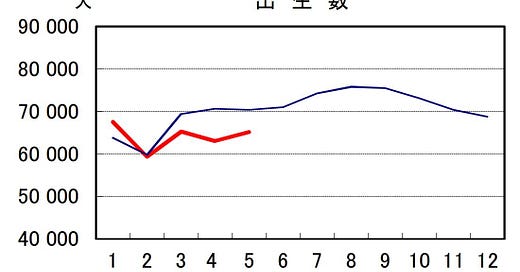Back in 2007, then Health Minister Hokuo Yanagisawa managed to get himself in the international headlines after discussing Japan’s low birth rate.
"The number of women aged between 15 and 50 is fixed," Mr Yanagisawa, 71, said. "Because the number of birth-giving machines and devices is fixed, all we can do is ask them to do their best per head ... although it may not be so appropriate to call them machines."
Fast-forward 15 years, and the output of Japan’s birth-giving machines has been noticeably lower in the last three months. The latest figures show a 7.5% year-on-year decline in live births in May, following similar declines in March and April.
And Japan is not the only country experiencing this problem. Live births have also decreased significantly in Germany, Taiwan, Hungary, and Sweden. However, those countries have seen larger drops than Japan: Taiwan’s birth rate fell 27.66% in June! One possible spanner is the works is thought to be the Covid jabs.
Other more scientifically knowledgeable substackers than I have already written about peer-reviewed studies detailing menstrual changes in women…
…and lower sperm counts in men…
…following mRNA injections, so please see their excellent posts if these disturbing findings are news to you. The menstrual changes may have some association with birth rates, but since lower sperm counts have been confirmed, I’ll refer to the idea that the jabs are causing lower birth rates as the shot-in-the-sack (SITS) hypothesis.
So how do we test this hypothesis in Japan’s case? Babies born in April and May would presumably have been conceived in July and August. So how far along was Japan’s jab campaign during those months?
Only 7.5% of Japanese aged 12-64 had taken their first shot by 1st June, rising to 13.8% on 1 July, 35.0%, on 1 August, 55.8% on 1 September, 75.9% on 1 October, and 85.6% on 1 November. One possible argument against the SITS hypothesis based on these numbers is that births were higher in May than in April (65,190 vs 63,066) with a smaller year-on-year decline (7.5% vs 10.6%). But then what led to the lower birth rate from March after no year-on-year decline in January or February?
If the jabs are causing Japan’s birth-giving and sperm-shooting machines to malfunction, the year-on-year decreases can be expected to continue over the next few months in Japan and elsewhere. Let’s hope the SITS hypothesis turns out to be wrong.
Update 26th July
One potential behavioural explanation is put forward by Swiss Policy Research: fewer marriages in 2021 leading to fewer babies in 2022 (hat-tip to commenter Claes Heitman). Marriages in Japan went down from 525,507 in 2020 to 501,116 in 2022 (4.75% lower). This is a bit smaller than the decline in births, but it may be part of the puzzle.








This is bad news, but an incredible find! Thanks!
there are other possible causes according to this Swiss analysis: https://swprs.org/birth-rates-vaccinations-marriages/ fewer marriages, women delaying pregnancy?